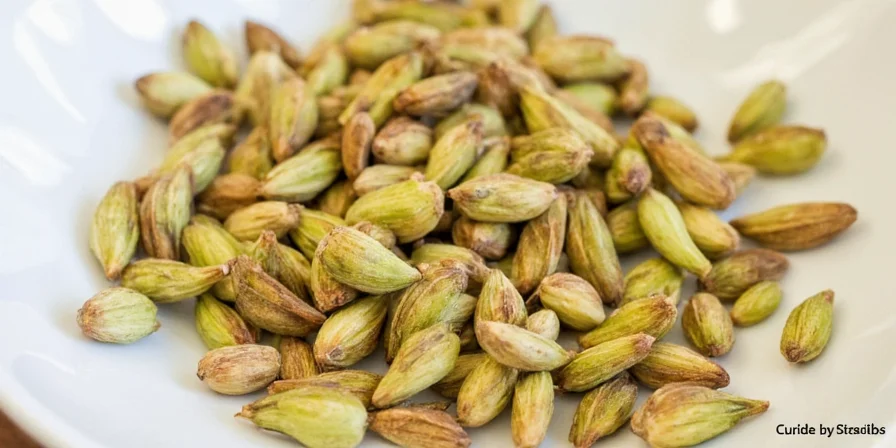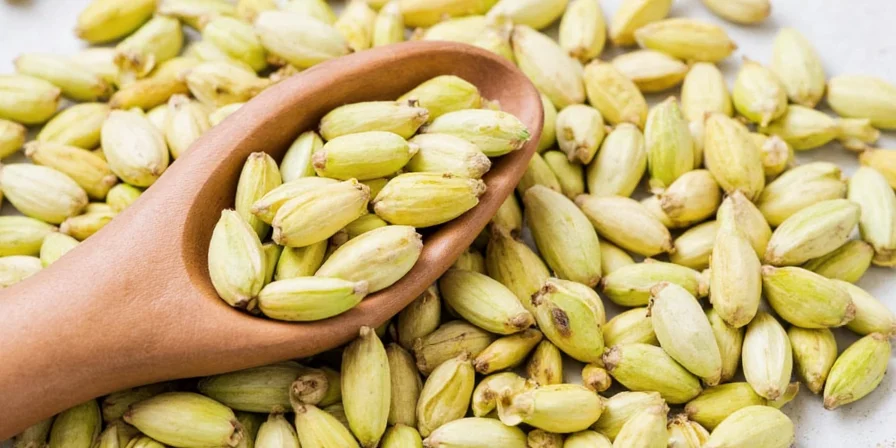The Secret to Perfect Cardamom Flavor: Storage and Usage Hacks for the Culinary Curious

Have you ever opened a jar of cardamom, only to be disappointed by its muted flavor or the odd, almost bitter aftertaste? You're not alone. Cardamom, often referred to as the “queen of spices,” is a powerhouse of flavor, but it’s also one of the most misunderstood. If you're like me, you’ve probably asked yourself, What does cardamom taste like? Well, the answer is both complex and delightful — a sweet, floral, and peppery blend that can elevate everything from coffee to desserts. But for cardamom to deliver that perfect punch, it needs to be stored and used correctly. In this blog, we’ll dive deep into the world of cardamom, explore its flavor profile, and give you a comprehensive guide on how to store and use this aromatic treasure like a pro.
What Does Cardamom Taste Like? A Flavor Breakdown
If you're wondering, what does cardamom taste like, here's the short answer: It’s like a symphony of sweet, floral, and peppery notes, with a hint of citrus and spice. But let's break it down in more detail.
- Sweetness: Cardamom has a natural sweetness that’s not overpowering, similar to vanilla or cinnamon but more refined.
- Floral Notes: Think of rose petals, jasmine, or even a hint of orange blossom — cardamom carries a floral aroma that adds depth to any dish.
- Peppery Spiciness: The green variety, in particular, has a subtle heat that lingers on the tongue, like a gentle kick of black pepper.
- Citrus Undertones: Some people detect a hint of lime or lemon in cardamom, especially in the green pods.
- Earthy and Woody: The black variety tends to be more earthy, with a woody, almost smoky character.
So, when you're cooking with cardamom, you’re not just adding a single note — you're adding an entire orchestra of flavors. This makes it a versatile spice that can be used in both sweet and savory dishes, from Indian curries to Scandinavian breads and even in cocktails.
Why Cardamom is a Must-Have in Your Spice Cabinet
Cardamom is more than just a flavor booster; it’s a spice that carries a rich history and cultural significance. Used in ancient Ayurvedic and Chinese medicine, cardamom has long been valued for its digestive, anti-inflammatory, and even aphrodisiac properties. But in the modern kitchen, it’s a gem that can transform any dish.
Here are a few reasons why cardamom deserves a prime spot in your spice cabinet:
- Versatile: It works in sweet, savory, and even savory-sweet dishes.
- Complex Flavor: Unlike many spices that are one-note, cardamom has layers of flavor that can be manipulated based on how it’s used.
- Cultural Significance: It’s a staple in Indian, Middle Eastern, and Scandinavian cuisines, giving your cooking an international flair.
- Health Benefits: Studies suggest that cardamom may support digestion, reduce inflammation, and even improve breath.
Now that we’ve covered the basics, let’s get into the real meat of this blog: how to store and use cardamom like a pro.
The Ultimate Cardamom Storage Guide: Keeping It Fresh and Flavorful
Cardamom, like many spices, is sensitive to heat, light, and moisture. If stored improperly, it can lose its potency and flavor in as little as a few months. Here are some pro tips to ensure your cardamom stays fresh, fragrant, and ready to use at any time.
1. Store in an Airtight Container
The first and most important rule of spice storage is to keep it in an airtight container. Exposure to air can cause cardamom to lose its oils and aroma over time. Glass jars with tight-fitting lids are ideal — they’re not only airtight, but they also allow you to see how much you have left, which is always a bonus.
2. Keep It Cool and Dark
Cardamom should be stored in a cool, dark place, away from direct sunlight and heat sources. A pantry or spice cabinet is perfect. Avoid storing it near the stove or in the fridge (unless you plan to use it within a few weeks — even then, the fridge can cause condensation, which is bad for spices).
| Storage Location | Recommended | Not Recommended |
|---|---|---|
| Pantry | ✔️ | ✖️ |
| Spice Cabinet | ✔️ | ✖️ |
| Refrigerator | ✖️ (unless short-term) | ✔️ (if short-term) |
| Freezer | ✖️ | ✔️ |
| Direct Sunlight | ✖️ | ✔️ |
3. Avoid Moisture
Moisture is the enemy of all spices, including cardamom. It can cause clumping, mold, and even bacterial growth. Keep your cardamom away from humid areas like the bathroom or near the sink. If you live in a particularly humid climate, consider using a desiccant (like silica gel packets) in your storage container to absorb excess moisture.
4. Use in Small Quantities
Cardamom is a potent spice, so a little goes a long way. If you’re using whole pods, it’s best to grind them just before use to preserve the oils and aroma. If you buy pre-ground cardamom, use it within a few weeks for best results.
Here’s a quick reference guide for how long cardamom lasts under different storage conditions:
| Storage Condition | Shelf Life |
|---|---|
| Airtight container in a cool, dark place | 6–12 months |
| Refrigerated | 3–6 months |
| Exposed to light or heat | 1–2 months |
Now that we’ve covered how to store cardamom, let’s move on to how to use it — because a well-stored spice is only half the battle. The other half is knowing how to bring out its full potential in your cooking.
Cardamom Usage Hacks: How to Use It Like a Pro
Cardamom is a versatile spice, but it’s also a tricky one. Too much, and it can overpower your dish. Too little, and it might be barely noticeable. Here are some pro tips to help you use cardamom like a seasoned chef.
1. Toast Whole Pods for Maximum Flavor
One of the best ways to bring out the full flavor of cardamom is to toast whole pods in a dry pan over medium heat. This releases the oils and enhances the aroma. Let them cool before cracking open the pods and using the seeds.
2. Grind Just Before Use
If you’re using cardamom in a recipe, it’s best to grind it just before adding it to your dish. Pre-ground cardamom can lose its potency quickly. A mortar and pestle or a spice grinder works great for this.
3. Use in Both Sweet and Savory Dishes
Cardamom is a unique spice that works in both sweet and savory dishes. Here are some ideas:
- Savory: Use in biryanis, curries, stews, and even in coffee or tea.
- Sweet: Add to cakes, cookies, rice pudding, and even cocktails.
For example, in Indian cuisine, cardamom is a key ingredient in biryanis and chai. In Scandinavian baking, it’s used in cardamom buns (kanelbullar). In Middle Eastern cuisine, it’s used in desserts like baklava.
4. Use in Drinks
Cardamom is a popular spice in beverages. It’s a key ingredient in masala chai and is also used in cardamom coffee and cardamom-infused cocktails. For a quick and easy drink, simply add a few cardamom pods to your coffee or tea and let them steep for a few minutes.
5. Use in Baking
Cardamom is a staple in many baked goods, especially in Scandinavian and Middle Eastern cuisines. It pairs well with cinnamon, nutmeg, and ginger. Here are a few baked goods that make great use of cardamom:
- Cardamom bread
- Cardamom cookies
- Cardamom cake
- Cardamom rice pudding
When using cardamom in baking, it’s best to use the green variety, as it has a fresher, more floral flavor than black cardamom.
Common Mistakes to Avoid When Using Cardamom
Even with the best intentions, it’s easy to make mistakes when using cardamom. Here are some common pitfalls to avoid:
- Overusing it: Cardamom is potent, so a little goes a long way. Start with a small amount and adjust to taste.
- Using old cardamom: Old cardamom can be bitter and lose its flavor. Always use fresh cardamom for the best results.
- Using the wrong variety: Green and black cardamom have different flavor profiles. Green is more floral, while black is more earthy. Use the right one for the right dish.
- Not toasting it: Toasting whole pods enhances the flavor. Don’t skip this step if you want the best flavor.
Now that we’ve covered the basics of storing and using cardamom, let’s wrap things up with a quick recap and some final thoughts.
Final Thoughts: Mastering Cardamom in the Kitchen
Cardamom is a spice that deserves a place in every kitchen. It’s versatile, flavorful, and packed with benefits. But to make the most of it, you need to store it properly and use it correctly. By following the tips in this blog, you’ll be able to use cardamom like a pro and bring out its full potential in your cooking.
If you're still wondering, what does cardamom taste like? It's a complex and delightful mix of sweet, floral, and peppery notes that can transform any dish. So go ahead — open that jar, toast those pods, and let the magic begin.
Happy cooking and spice-storing!

Whether you're making a cup of cardamom coffee, baking a cardamom cake, or simmering a cardamom stew, the key to success is using high-quality cardamom that’s been stored and used properly. With these hacks in your arsenal, you’ll be on your way to becoming a cardamom connoisseur in no time.
So, what are you waiting for? Grab your cardamom, and get cooking!










 浙公网安备
33010002000092号
浙公网安备
33010002000092号 浙B2-20120091-4
浙B2-20120091-4